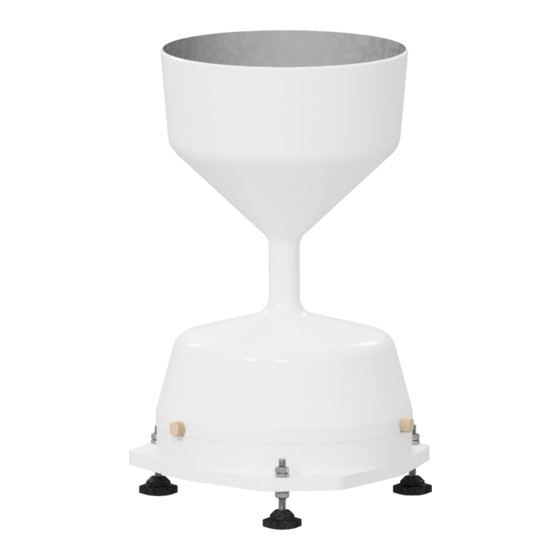
Table of Contents
Advertisement
Quick Links
Advertisement
Table of Contents

Summary of Contents for EML SBS
- Page 1 SBS Range Rain Gauge User Manual UM-780-400-SBS Manual – V2.00...
- Page 2 The contents are subject to change without prior notice. Please observe that this manual does not create any legally binding obligation for EML towards the customer or end user. All legally binding commitments and agreements are included exclusively in the applicable supply contract or Conditions of Sale.
-
Page 3: Table Of Contents
Maintenance and Calibration ....................... 10 Basic Maintenance ..........................10 Calibration ............................11 Specifications ..........................12 Gauge Specifications ......................... 12 Cable Specifications (if fitted) ......................13 Appendix A – SBS500 products, accessories and spares ..............14 UM-780-400-SBS Manual – V2.00 P a g e... -
Page 4: List Of Figures
Figure 5 - Internal photograph highlighting water drains ..............10 Figure 6 - SBS replaceable reed switch (left) / Empty socket to house one of the reed switches (centre) / reed switch being inserted into the empty socket............... 11 List of Tables Table 1 - Document Revisions ......................... -
Page 5: General Information
This manual is intended as a general guide for installing, wiring and using the SBS range of rain gauges. There are three models of SBS gauge, but the guidelines for each are the same so the generic term of reference used is ‘SBS’. The information contained in this manual may not cover all aspects of SBS applications. -
Page 6: Introduction
The gauge should ideally be no closer than at least twice the height of the obstruction. Although the SBS rain gauge is designed to operate in higher wind speeds, care must still be taken to avoid over-exposing the gauge where possible. -
Page 7: Levelling The Rain Gauge
There are options which can be used to mount the SBS above the ground. The SBS can be purchased with a rain gauge pedestal and guy kit or a rain gauge pedestal only. An example of this configuration is shown in Figure 2. -
Page 8: Wiring Guidelines
Figure 2 - SBS500 fitted to a pedestal as part of the EML system 4. Wiring Guidelines This section gives information on the wiring of SBS rain gauge. For most applications, the rain gauge may be connected directly to a pulse counting input (contact closure) on a data logger, but some care is needed if long cables are used. -
Page 9: Field Replaceable Dual Reed Switches
Field replaceable dual reed switches SBS gauges are fitted with dual reed switches. This means that 2 data outputs can be logged using the same tipping bucket mechanism. It is an important feature providing built-in redundancy which is often critical for professional users such as National Meteorological Services. Another feature of the reed switches is that they are replaceable in the field. -
Page 10: Maintenance And Calibration
UM-780-400-SBS Manual – V2.00 10 | P a g e... -
Page 11: Calibration
(Note: IP67 means Dust Tight (6) and Immersion up to 1m (7)). Figure 6 - SBS replaceable reed switch (left) / Empty socket to house one of the reed switches (centre) / reed switch being inserted into the empty socket. -
Page 12: Specifications
Typical Accuracy 99% up to 120mm/hr SBS314 (0-1750 mm/hr), SBS500 (0-1200mm/hr), Rainfall Intensity SBS1000 (0-600mm/hr), With mathematical correction over 120mm/hr - contact EML Operating Temperature 1°C - 70°C Funnel Diameter SBS314 (20cm), SBS500 (25.2cm), SB1000 (35.7cm) SBS314 (314cm Funnel Area... -
Page 13: Cable Specifications (If Fitted)
Table 4 - Cable Specifications (if fitted) Technical Specifications Temperature Range -30°C to +70°C Overall diameter 4.6 mm 85 Char. impedance Capacitance/metre 154 pF Alpha 2401 Equivalents Belden 8761 UL style2092 UM-780-400-SBS Manual – V2.00 13 | P a g e... -
Page 14: Appendix A - Sbs500 Products, Accessories And Spares
SBS1000/H (24v) Rain gauge P-780-4121 SBS1000 Rain gauge (0.005 inch) Table 6 - Accessories for the SBS500 Product code Description P-780-188 Rain gauge Pedestal + Guy Kit P-780-189 ARG/SBS Pedestal UM-780-400-SBS Manual – V2.00 14 | P a g e... -
Page 15: Table 7 - Spare Parts For The Sbs Gauges
Table 7 - Spare parts for the SBS gauges Product code Description P-780-415 SBS Bucket Assembly P-780-425 SBS Reed Switches P-780-430 SBS Casting Assembly P-780-450 SBS500 Funnel Assembly P-780-451 SBS1000 Funnel Assembly P-780-453 SBS314 Funnel Assembly P-780-490 Spares Kit (includes funnel screws, filter material and filter cap) UM-780-400-SBS Manual –...

Need help?
Do you have a question about the SBS and is the answer not in the manual?
Questions and answers